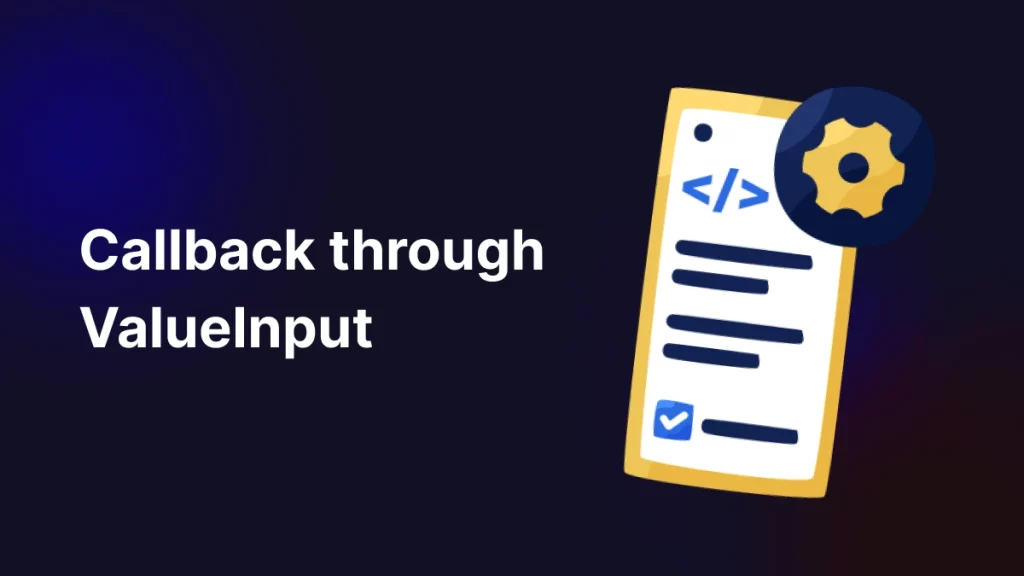Hello, Flutter devs! Today, let’s dive into callbacks through ValueChanged to boost interactivity in your Flutter apps. Let’s go!

Prerequisite
Before we explore callbacks, it’s essential to grasp the basics of Flutter and Dart.
ValueChnaged in Flutter applies to various scenarios, so you should have at least a basic knowledge of classes (Stateful/Stateless), functions, and generic parameters.
Now, let’s dive deeper into what ValueChanged is and how it works in practice!
What is ValueChanged?
The ValueChanges is a signature for callbacks that report that an underlying value has changed.
In other words, ValueChanged is a function signature that takes a single generic type argument of type T and doesn’t return anything (void).
|
1 |
typedef ValueChanged<T> = void Function(T value); |
ValueChanged notifies the app of value changes. It appears in input widgets, capturing user actions like typing, selecting from a dropdown, or adjusting a slider.
Where is ValueChanged Used?
ValueChanged captures non-null user input with a generic return type. It’s widely used in widgets like TextField, Slider, and Switch to respond to interactions and update the UI.
Although we can perform the same task with a Function as a callback, using callbacks through ValueChanged offers better clarity and type safety, making the code more readable and easier to maintain.
How to use ValueChanged?
Let’s create a class that performs actions and sends a response each time an action occurs.
|
1 2 3 4 5 6 7 8 9 10 11 12 13 14 15 16 |
class CustomSliderClass extends StatelessWidget { final double value; final ValueChanged<double> onChanged; MySlider({required this.value, required this.onChanged}); @override Widget build(BuildContext context) { return Slider( value: value, min: 0, max: 100, onChanged: onChanged, // Use the ValueChanged callback ); } } |
As we can see, the above CustomSliderClass has an onChanged ValueChnaged and is working as a callback to return the data from onChanged of the Slider class.
|
1 2 3 4 5 6 7 8 9 10 11 12 13 14 15 16 17 18 19 20 21 22 23 24 25 26 |
class MyWidget extends StatefulWidget { @override _MyWidgetState createState() => _MyWidgetState(); } class _MyWidgetState extends State<MyWidget> { double _sliderValue = 50; @override Widget build(BuildContext context) { return Column( children: [ CustomSliderClass( value: _sliderValue, onChanged: (newValue) { setState(() { _sliderValue = newValue; }); }, ), Text('Slider Value: $_sliderValue'), ], ); } } |
Callback with Function vs. ValueChanged in Flutter
In Flutter, both Function and ValueChanged work as callbacks, each with unique advantages based on project context. Here’s an overview of their differences:
- Type Safety
- Function: It can take any kind of function, with any parameters or return type. This flexibility can obscure the function’s purpose, making code more complex and harder to organize.
- ValueChanged: It’s specifically designed for handling changes to a single value. By using a set type and structure, it keeps things clear and consistent, making your code easier to understand and maintain.
- Clear Purpose and Readability
- Function: It doesn’t clearly show its purpose. It can take any parameters and perform any kind of action, making it less obvious what it’s meant to do. This flexibility can sometimes make the code harder to understand.
- ValueChanged: It clearly indicates it’s meant to handle a single value change, making the code more readable and easy to understand.
- Consistent Code Structure
- Function: Offers flexibility, but can lead to inconsistencies when used with different types and parameters.
- ValueChanged: Ensures consistency by using a standardized method for value changes, particularly in widgets like TextField, Slider, and Switch.
Conclusion
In conclusion, ValueChanged provides a clear, type-safe way to handle single-value changes in Flutter, enhancing code readability and consistency.
Discover more insightful Flutter content and make your development journey even more fruitful with Mobikul Blogs. Happy coding!

Be the first to comment.